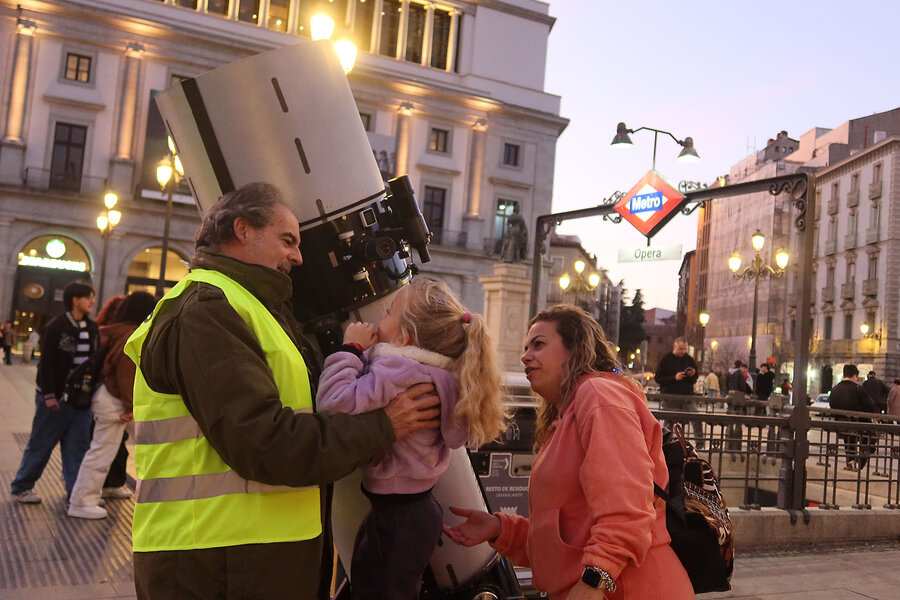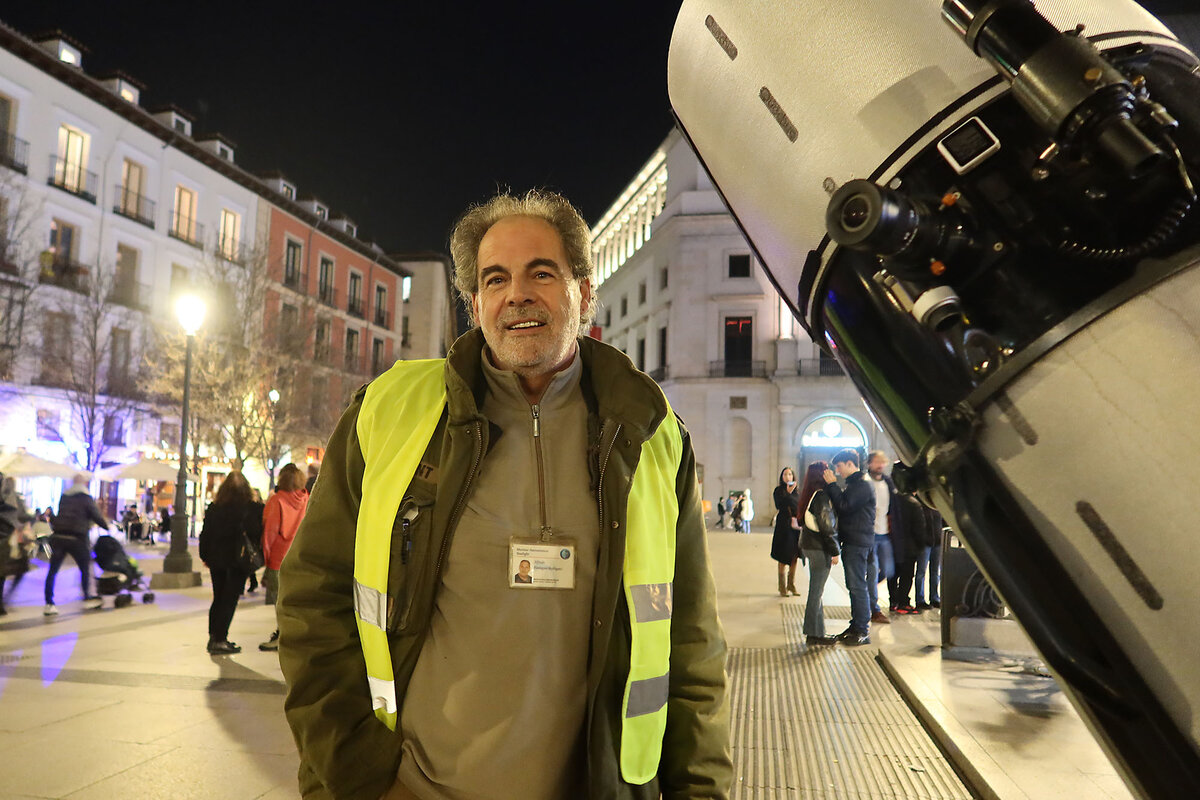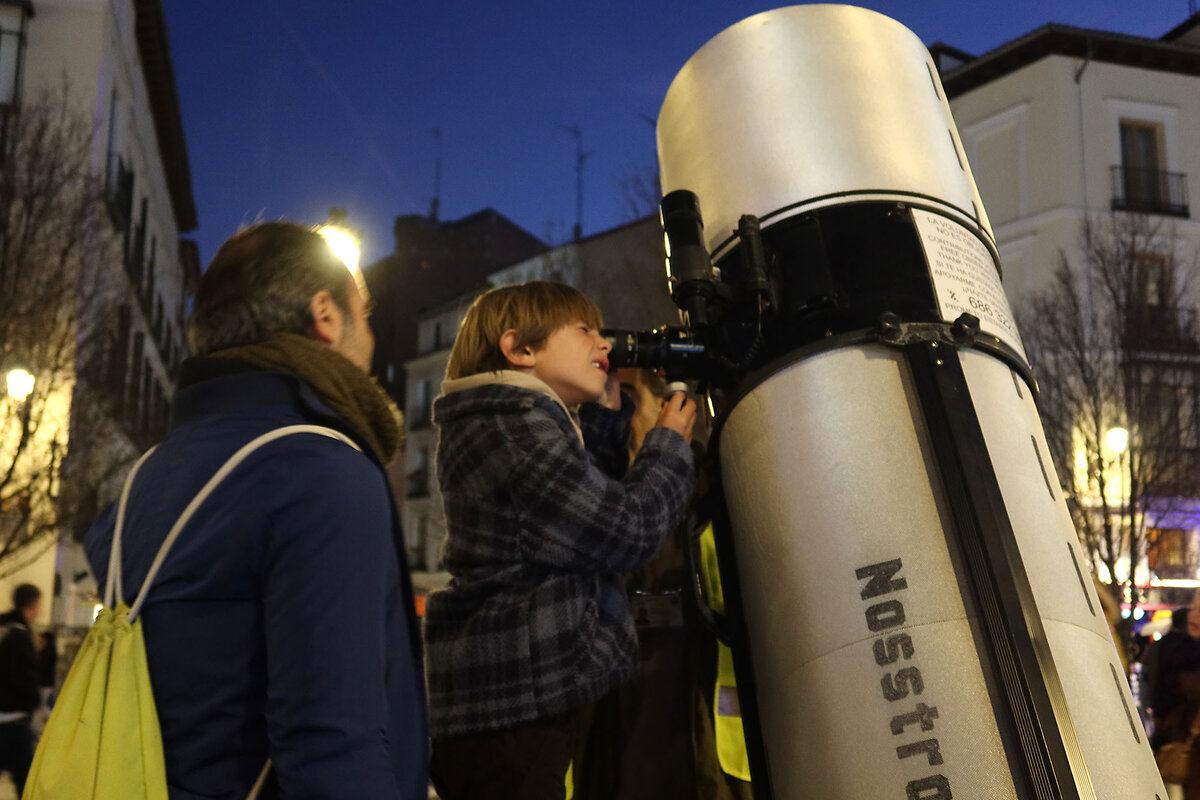A sidewalk telescope in Madrid offers a glimpse into the night sky’s unknown
Loading...
| Madrid
As the rest of the city heads out on a Friday evening, Alfredo Paniagua dons a lime-green vest, loads his 180-pound telescope into a van, and drives into the center of Madrid.
He sets up the telescope at the mouth of the busy Ópera metro station, a block from the Royal Palace. The sun still setting, he swivels the massive cylinder to an invisible point in the sky and fiddles with the focuser. And then he waits.
It doesn’t take long for curiosity to pique. Children tug on sleeves and point. Friends dressed for an evening out stop to ask what’s up there.
Why We Wrote This
A story focused onThe stars have inspired wonder and contemplation from time immemorial. On Madrid’s sidewalks, one man is helping locals experience them today with a glimpse through his telescope.
“Jupiter,” says Mr. Paniagua. “The view is spectacular tonight.”
A line begins to take shape, curious passersby waiting their turn to peek through the lens. Mr. Paniagua places a footstool for those who need it and lifts the smallest kids up himself. He shows each viewer how to focus the image. Then he steps back for his favorite part. Eyebrows raised, he watches face after face light up at the sight: a perfectly round ball of bright gas marked by two clear stripes near its equator, tiny to the eye yet big enough to fit 1,321 Earths. Four moons stretch out in a straight line below.
He gives visitors their own time with the infinite, jumping in with information only when asked. What are those dots? How many moons does Jupiter have? How far away is it?
It’s a nightly ritual Mr. Paniagua has performed for two decades, whenever the sky is clear. He often stays past midnight, sharing his telescope with hundreds of strangers free of charge. Many leave a donation, which he accepts.
It’s not that the center of Madrid is the best place for stargazing – there’s too much light pollution to see much besides Jupiter, Saturn, and the moon. “But it’s difficult to bring lots of people to where you can see things well,” says Mr. Paniagua. So he goes where the people are.
“I like to think that they begin to ask themselves new questions.”
“We are teeny tiny, and this is immense”
For as long as there has been a record, the night sky has captured imaginations from every corner of the world. For Mr. Paniagua and countless others, there is something transformative about that feeling of unfathomable vastness. And a growing body of psychological research is corroborating what philosophers and religious thinkers have long posited – that awe and wonder are a central part of what it means to be human, connected to a wider whole.
“These are two emotions that help you to step outside of yourself,” says Helen De Cruz, a professor of philosophy at Saint Louis University and author of “Wonderstruck: How Wonder and Awe Shape the Way We Think.” It’s one thing to look at pictures from the James Webb telescope online, she adds. It’s another to catch a glimpse of the distant universe yourself in a neighborhood telescope.
“You get this sense of insignificance,” she says. At the same time, “you’re part of this big world somehow.”
That’s what Ana Afonso Martin says she felt looking through Mr. Paniagua’s telescope. She and three friends just arrived from the Canary Islands for a weekend in Madrid. Jupiter was the last thing she expected to find in the capital.
“We are teeny tiny, and this is immense,” she says. “If you’re always stuck in your world, and you don’t look up at the sky, you don’t realize that.”
It’s also what pulled Mr. Paniagua into the fold 25 years ago. At the time, he was working odd jobs, mostly as a metalworker, on the outskirts of Madrid. He heard word of a free astronomy course offered by someone in his neighborhood, and signed up.
It was Saturn that hooked him, on the last day of the class. From there, he and a few others formed the Agrupación Astronómica Madrid Sur (South Madrid Astronomical Association) and began bringing an old telescope to schools, hospitals, small towns, and whoever invited them. Most of what he has learned he taught himself, though he eventually became a certified astronomy monitor through the Starlight Foundation, a nonprofit dedicated to promoting and protecting the night sky. Over time he realized that to reach the most people, he needed to be out on the street.
Something that shouldn’t be taken for granted
So-called sidewalk astronomy dates back to at least the 19th century and was popularized more recently by the late amateur astronomer John Dobson. The value of a telescope should not be measured by size or sophistication, but by “how many people ... got to look through it,” Mr. Dobson said in a 1994 interview.
Meanwhile, a growing dark-sky movement is working to protect the night from light pollution, which grew by nearly 10% every year between 2011 and 2022. For his regular fans, Mr. Paniagua is giving people the chance to appreciate something that shouldn’t be taken for granted.
“It’s wonderful, this curiosity about science,” says Mariano Gorroñogoitia, who lives nearby and often stops to greet Mr. Paniagua. “This feeds the spirit.” Mr. Gorroñogoitia points to a light traveling across the sky, now long dark. “Guys, that’s the International Space Station,” Mr. Paniagua calls out down the line. Necks arch upward in response.
Finally his turn, Héctor Bueno approaches the telescope shyly. The boy climbs onto the step stool and squints into the eyepiece, finding just the right angle. His father watches from behind, curious. His mother snaps a photo on her phone.
A few long moments later, Héctor pulls away from Jupiter and comes back down to Earth. Mr. Paniagua is waiting with a smile.
“Did you see it?” he asks, knowing the answer.
Héctor nods, eyes wide. Before his parents can walk away, he gets in line again.









